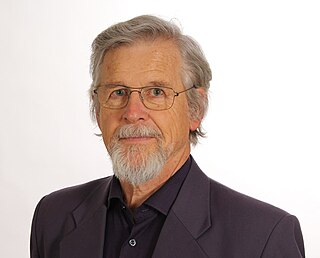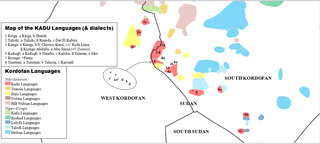Ethnologue: Languages of the World is an annual reference publication in print and online that provides statistics and other information on the living languages of the world. It is the world's most comprehensive catalogue of languages. It was first issued in 1951, and is now published by SIL International, an American evangelical Christian non-profit organization.
Sociolinguistics is the descriptive study of the effect of any or all aspects of society, including cultural norms, expectations, and context, on language and the ways it is used. It can overlap with the sociology of language, which focuses on the effect of language on society. Sociolinguistics overlaps considerably with pragmatics and is closely related to linguistic anthropology.
Linguistic imperialism or language imperialism is occasionally defined as "the transfer of a dominant language to other people". This language "transfer" comes about because of imperialism. The transfer is considered to be a sign of power; traditionally military power but also, in the modern world, economic power. Aspects of the dominant culture are usually transferred along with the language. In spatial terms, indigenous languages are employed in the function of official (state) languages in Eurasia, while only non-indigenous imperial (European) languages in the "Rest of the World". In the modern world, linguistic imperialism may also be considered in the context of international development, affecting the standard by which organizations like the International Monetary Fund and the World Bank evaluate the trustworthiness and value of structural adjustment loans by virtue of views that are commonly foregrounded in English-language discourse and not neutral.
Language policy is both an interdisciplinary academic field and implementation of ideas about language use. Some scholars such as Joshua Fishman and Ofelia García consider it as part of sociolinguistics. On the other hand, other scholars such as Bernard Spolsky, Robert B. Kaplan and Joseph Lo Bianco argue that language policy is a branch of applied linguistics.
In sociolinguistics, an abstand language is a language variety or cluster of varieties with significant linguistic distance from all others, while an ausbau language is a standard variety, possibly with related dependent varieties. Heinz Kloss introduced these terms in 1952 to denote two separate and largely independent sets of criteria for recognizing a "language":

Robert Henry Lawrence Phillipson is Professor Emeritus in the Department of Management, Society and Communication at Copenhagen Business School in Denmark. He is best known for his seminal work on linguistic imperialism and language policy in Europe.

In linguistics, language death occurs when a language loses its last native speaker. By extension, language extinction is when the language is no longer known, including by second-language speakers, when it becomes known as an extinct language. A related term is linguicide, the death of a language from natural or political causes, and, rarely, glottophagy, the absorption or replacement of a minor language by a major language.

Sociology of language is the study of the relations between language and society. It is closely related to the field of sociolinguistics, which focuses on the effect of society on language. One of its longest and most prolific practitioners was Joshua Fishman, who was founding editor of the International Journal of the Sociology of Language, in addition to other major contributions. The sociology of language studies society in relation to language, whereas sociolinguistics studies language in relation to society. For the former, society is the object of study, whereas, for the latter, language is the object of study. In other words, sociolinguistics studies language and how it varies based on the user's sociological background, such as gender, ethnicity, and socioeconomic class. On the other hand, sociology of language studies society and how it is impacted by language. As Trent University professor of global politics Andreas Pickel states, "religion and other symbolic systems strongly shaping social practices and shaping political orientations are examples of the social significance such languages can have." The basic idea is that language reflects, among several other things, attitudes that speakers want to exchange or that just get reflected through language use. These attitudes of the speakers are the sociologist's information.

Einar Ingvald Haugen was an American linguist, writer, and professor at University of Wisconsin–Madison and Harvard University.

The Kadu languages, also known as Kadugli–Krongo or Tumtum, are a small language family of the Kordofanian geographic grouping, once included in Niger–Congo. However, since Thilo Schadeberg (1981), Kadu is widely seen as Nilo-Saharan. Evidence for a Niger-Congo affiliation is rejected, and a Nilo-Saharan relationship is controversial. A conservative classification would treat the Kadu languages as an independent family.
Ecolinguistics, or ecological linguistics, emerged in the 1990s as a new paradigm of linguistic research, widening sociolinguistics to take into account not only the social context in which language is embedded, but also the wider ecological context, including other species and the physical environment.

Language geography is the branch of human geography that studies the geographic distribution of language(s) or its constituent elements. Linguistic geography can also refer to studies of how people talk about the landscape. For example, toponymy is the study of place names. Landscape ethnoecology, also known as ethnophysiography, is the study of landscape ontologies and how they are expressed in language.
Sociocultural linguistics is a term used to encompass a broad range of theories and methods for the study of language in its sociocultural context. Its growing use is a response to the increasingly narrow association of the term sociolinguistics with specific types of research involving the quantitative analysis of linguistic features and their correlation to sociological variables. The term as it is currently used not only clarifies this distinction, but highlights an awareness of the necessity for transdisciplinary approaches to language, culture and society.

Terralingua is a 501(c)(3) non-profit organization under U.S. tax law (#38–3291259) and a registered non-profit society in Canada based on Salt Spring Island in Vancouver, British Columbia whose mission is to support the integrated protection, maintenance and restoration of the biocultural diversity of life. Created in 1996, Terralingua's founders Luisa Maffi and Dave Harmon pioneered the concept and field of Biocultural Diversity, building on emergent ideas about the links between biological and cultural diversity.

José María Sánchez Carrión is a Spanish linguist, specialised in Basque language, sociolinguistics and historical linguistics. He is an associate member of Euskaltzaindia since 1983. Despite being arguably the best known local academic proponent of reversing language shift measures, he has never held a stable university post in the Basque Country.

The linguistic landscape refers to the "visibility and salience of languages on public and commercial signs in a given territory or region". Linguistic landscape research has been described as being "somewhere at the junction of sociolinguistics, sociology, social psychology, geography, and media studies". It is a concept which originated in sociolinguistics and language policy as scholars studied how languages are visually displayed and hierarchised in multilingual societies, from large metropolitan centers to Amazonia. For example, linguistic landscape scholars have described how and why some public signs in Jerusalem are presented in Hebrew, English, and Arabic, or a combination thereof. It also looks as how communication in public space plays a crucial role in the organisation of society.
Emili Boix-Fuster is a sociolinguist. His main academic interests are sociolects, intergenerational language transmission and linguistic ideologies in Catalan-speaking territories.
Linguonym, also known as glossonym or glottonym, is a linguistic term that designates a proper name of an individual language, or a language family. The study of language names is known as linguonymy, or linguonymics. As a distinctive linguistic discipline, linguonymic studies are closely related to some other onomastic disciplines, particularly those that are focused on the study of ethnonyms and choronyms. In that context, the field is related to ethnolinguistic and sociolinguistic studies. Various questions related to the study of formation and use of language names are also relevant for several other disciplines within social sciences and humanities.
The Torres–Banks languages form a linkage of Southern Oceanic languages spoken in the Torres Islands and Banks Islands of northern Vanuatu.

Ingrid Piller is an Australian linguist, who specializes in intercultural communication, language learning, multilingualism, and bilingual education. Piller is Distinguished Professor at Macquarie University and an elected fellow of the Australian Academy of the Humanities. Piller serves as Editor-in-Chief of the academic journal Multilingua and as founding editor of the research dissemination site Language on the Move. She is a member of the Australian Research Council (ARC) College of Experts.








